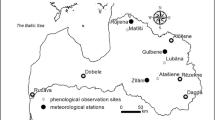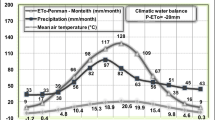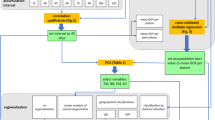Abstract
Six phenological series were available for ‘Golden Delicious’ apple blooming at six sites in Trentino, an alpine fruit-growing region. Several models were tested to predict flowering dates, all involving a “chilling and forcing” approach. In many cases, application of the models to different climatic conditions results in low accuracy of prediction of flowering date. The aim of this work is to develop a model with more general validity, starting from the six available series, and to test it against five other phenological series outside the original area of model development. A modified version of the “Utah” model was the approach that performed best. In fact, an algorithm using “chill units” for rest completion and a thermal sum for growing-degree-hours (GDH), whose efficiency changes over time depending on the fraction of forcing attained, yielded a very good prediction of flowering. Results were good even if hourly temperatures were reconstructed from daily minimum and maximum values. Errors resulting from prediction of flowering data were relatively small, and root mean square errors were in the range of 1–6 days, being <2 days for the longest phenological series. In the most general form of the model, the summation of GDH required for flowering is not a fixed value, but a function of topoclimatic variables for a particular site: slope, aspect and spring mean temperature. This approach allows extension of application of the model to sites with different climatic features outside the test area.









Similar content being viewed by others
References
Anderson JL, Richardson EA, Kesner CD (1986) Validation of chill unit and flower bud phenology models for “Montmorency” sour cherry. Acta Hortic 184:71–78
Anderson JL, Richardson EA (1982) Utilizing meteorological data for modeling crop and weed growth. In: Hatfield JL and Thomason IJ (eds) Biometeorology in integrated pest management, Academic, New York, pp 449–461
Ashraf M, Loftiss JC, Hubbard KG (1997) Application of geostatistics to evaluate partial weather station networks. Agric For Meteorol 84:225–271
Ashcroft LG, Richardson EA, Schuyler DS (1977) A statistical method of determining chill unit and growing degree hour requirements for deciduous fruit trees. HortScience 12:347–348
Bergant K, Črepinšek Z, Kajfez-Bogataj L (2001) Flowering prediction of pear tree (Pyrus communis L.), apple tree (Malus domestica Borkh) and plum tree (Prunus domestica L.)-similarities and differences. Research Reports, Biotechnical Faculty University of Ljubljana 77 (1)
Bidabé B (1967) Action de la température sur l’évolution des bourgeons de pommier et comparaison de méthodes de contrôle de l’époque de floraison. Ann Physiol vég 9:65–86
Brunetti A, Zinoni F (eds) (1999) Progetto Finalizzato PHENAGRI. Vol. 1 - Aspetti generali delle osservazioni agrofenologiche, Ministero delle Politiche Agricole e Forestali, Collana di Agrofenologia, Rome
Cacciamani C, Deserti M, Marletto V, Tibaldi S, Violetti SD, Zinoni F (2001) Mutamenti climatici. situazioni e prospettive. ARPA-Servizio Meteorologico Regionale. Quaderno tecnico ARPA-SMR n. 03/2001
Caffarra A, Chuine I, Donnelly A, Jones M (2005) Quantifying the environmental drivers of tree phenology. In: Proceedings of the 17th International Congress on Biometeorology, ICB 2005. Deutscher Wetterdienst, Annalen der Meteorologie 41, 2:493–497
Cannel MGR, Smith I (1986) Climatic warming, spring budburst and frost damage on trees. J Appl Ecol 23:177–191
Cannel MGR, Smith I, Murray MB (1989) Date of budburst of fifteen tree species in Britain following climatic warming. J Appl Ecol 26:693–700
Cesaraccio C, Spano D, Duce P, Snyder RL (2001) An improved model for determining degree-day values from daily temperature data. Int J Biometeorol 45:161–169
Cesaraccio C, Spano D, Snyder RL, Duce P (2004) Chilling and forcing model to predict bud-burst of crop and forest species. Agr For Meteorol 126:1–13
Chmielewski FM (2005) Climate changes and frost hazard for fruit trees. In: Proceedings of the17th International Congress on Biometeorology, ICB 2005. Deutscher Wetterdienst, Annalen der Meteorologie 41, 2:488–491
Chuine I (2000) A unified model for budburst of trees. J Theor Biol 207:337–347
Chuine I, Cour P (1999) Climatic determinants of budburst seasonality in four temperate-zone tree species. New Phytol 143:339–349
Chuine I, Cour P, Rousseau DD (1998) Fitting models prediciting dates of flowering of temperate-zone trees using simulated annealing. Plant Cell Environ 21:455–466
Chuine I, Cour P, Rosseau DD (1999) Selecting models to predict the timing of flowering of temperate trees: implications for tree phenology modelling. Plant Cell Environ 22:1–13
Črepinšek Z, Kaifez-Bogataj L, Bergant K (2006) Modelling of weather variability effect on fitophenology. Ecol Modelling 194:256–265
Cressie NAC (1993) Statistics for spatial data, revised edn. Wiley, New York
de Lemos Filho JP (1997) A model including photoperiod in degree days for estimating Hevea bud growth. Int J Biometeorol 41:1–4
Defila C, Clot B (2001) Phytological trends in different seasons, regions and altitudes in Switzerland. In: Walther GR et al (eds) Fingerprints of climatic change. Kluwer, pp 113–121
Fernàndez CJ (1992) Simulation of normal annual and diurnal temperature oscillations in non-mountainous mainland United States. Agron J 84:244–251
Floyd RB, Braddock RD (1984) A simple method for fitting average diurnal temperature curves. Agric For Meteorol 32:107–119
Guerriero R, Scalabrelli G (1991) Dormienza e fabbisogno in freddo nelle piante da frutto decidue. Riv Fruttic 2:75–84
Hänninen H (1991) Does climatic warming increase the risk of frost damage in northern trees? Plant Cell Environ 14:449–454
Jame YW, Cutforth HW, Ritchie JT (1998) Interaction of temperature and daylength on leaf appearance rate in wheat and barley. Agric For Meteorol 92:241–249
Johnson ME, Fitzpatrick EA (1977) A comparison of two methods of estimating a mean diurnal temperature curve during the daylight hours. Arch Met Geoph Biokl Ser B 25:251–263
Kajfez-Bogataj L, Bergant K (1998) Prediction of blossoming of apple tree (Malus domestica Borkh) by phenological models. Research Reports Biotechnical Faculty University of Ljubljana 71
Kitanidis PK (1997) Introduction to geostatistics: applications in hydrogeology, Cambridge University Press, Cambridge
Kramer K (1994) A modelling analysis of the effects of climatic warming on the probability of spring frost damage to tree species in The Netherlands and Germany. Plant Cell Environ 17:367–377
Kronenberg HG (1983) Relationships between temperatures and blooming dates of apple trees. Neth J Agric Sci 31:259–267
Landsberg JJ (1974) Apple fruit bud development and growth: analysis and an empirical model. Ann Bot 38:1013–1023
Lennon JJ, Turner JRG (1995) Predicting the spatial distribution of climate: temperature in Great Britain. J Anim Ecol 64:370–392
Masle J, Doussinault G, Farquhar GD, Sun B (1989) Foliar stage in wheat correlates better to photothermal time than to thermal time. Plant Cell Environ. 12:235–247
Menzel A, Estrella N (2001) Plant phenological changes. In: Walther GR et al (eds) Fingerprints of climatic change, Kluwer, pp 123–137
Menzel A (2003) Plant phenology anomalies in Germany and their relation to air temperature and NAO. Climatic Change 57:243–263
Rea R, Eccel E (2004) Utilizzo di Grass e R per interpolazione di dati meteorologici in una valle alpina. Geomatic Workbooks 4 ISSN 1591-092X-URL http://www.geomatica.como.polimi.it
Regniere J (1996) A generalized approach to landscape-wide seasonal forecasting with temperature-driven simulation models. Environ Entomol 25:869–881
Reicosky DC, Winkelman LJ, Baker JM, Baker DG (1989) Accuracy of hourly air temperatures calculated from daily minima and maxima. Agric For Meteorol 46:193–209
Richardson EA, Seeley SD, Walker DR (1974) A model for estimating the completion of rest for “Redhaven” and “Elberta” Peach Trees. Hort Science 9:331–332
Schwartz MD, Ahas R, Aasa A (2006) Onset of spring starting earlier across the Northern Hemisphere. Global Change Biol 12:343–351
Simonini G (1995) Variazioni di temperatura e precipitazione in Emilia-Romagna. AER, n.1/95:12–15
Snyder LR, Spano D, Cesaraccio C, Duce P (1999) Determining degree-day thresholds from field observations. Int J Biometeorol 42:177–182
Stampfli A (2001) Did recent climatic shifts affect productivity of grass-dominated vegetation in southern Switzerland. In: Walther GR et al (eds) Fingerprints of climatic change, Kluwer, pp 249–261
Valentini N, Me G, Ferrero R, Spanna F (2001) Use of bioclimatic indexes to characterize phenological phases of apple in Northern Italy. Int J Biometeorol 45:191–195
Walther GR, Carraro G, Klötzli F (2001) Evergreen broad-leaved species as indicators for climate change. In: Walther GR et al (eds) Fingerprints of climatic change, Kluwer, pp 151–162
Wang JY (1960) A critique of the heat unit approach to plant response studies. Ecology 41:785–790
Wann M, Doreen Y, Harvey JG (1985) Evaluation and calibration of three models for daily cycle of air temperature. Agric For Meteorol 34:121–128
White LM (1979):Relationships between meteorological measurements and flowering of index species to flowering of 53 plant species. Agric Meteorol 20:189–204
White MA, Thornton PE, Running SW (1997) A continental phenology model for monitoring vegetation responses to interannual climatic variability. Global Biogeochemical Cycles 11:217–234
White MA, Brunsell N, Schwartz MD (2003) Vegetation phenology in global change studies. In: Schwartz (eds) Phenology: an integrative environmental science. Kluwer, pp 453–466
Winter F (1986) A simulation model of phenology and corresponding frost resistance of “Golden Delicious” Apple. Acta Hortic 184:103–108
Wolfe DW, Schwartz MD, Lakso AN, Otsuki Y, Pool RM, Shaulis NJ (2005) Climate change and shifts in spring phenology of three horticultural woody perennials in northeastern USA. Int J Biometeorol 49:303–309
Worner SP (1988) Evaluation of diurnal temperature models and thermal summation in New Zealand, Forum. J Econ Entomol 81:9–13
Zinoni F, Antolini G (2002) The effect of climate modifications on the risks of freezing (winter, precocious, late) and on the cold requirements of cultivated-species. Proceedings of First Technical Workshop of the Mediterranean component of CLIMAGRI project on Climate Change and Agriculture, FAO, Rome 25–27 September
Acknowledgements
This work was funded in the framework of project “GEPRI” by the Autonomous Administration of the Province of Trento (PAT). The authors would like to thank C. Dalsant and T. Pantezzi (IASMA), Ufficio Previsioni e Organizzazione (PAT), O. Facini and M. Nardino (CNR - IBIMET, Bologna) and F. Spanna (Regione Piemonte) for the collection and delivery of phenological and meteorological data.
Author information
Authors and Affiliations
Corresponding author
Rights and permissions
About this article
Cite this article
Rea, R., Eccel, E. Phenological models for blooming of apple in a mountainous region. Int J Biometeorol 51, 1–16 (2006). https://doi.org/10.1007/s00484-006-0043-x
Received:
Revised:
Accepted:
Published:
Issue Date:
DOI: https://doi.org/10.1007/s00484-006-0043-x




